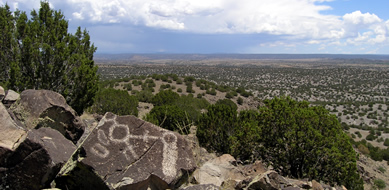
Petroglyph Hill
Galisteo Basin Sites
- Lamy Jct
- Lower Arroyo Hondo Pueblo
- El Camino Real
- Chamisa Locita
- El Crestón
- Espinoso Ridge Pueblo
- La Cienega Pueblo (LA 3)
- La Cienega Pithouse Village
- La Cieneguilla Pueblo (LA 16)
- La Cieneguilla Petroglyphs
- Manzanares Pueblo
- Paa-ko
- Petroglyph Hill
- Pueblo Blanco
- Pueblo Colorado
- Pueblo Galisteo
- Pueblo Largo
- Pueblo San Cristóbal
- Pueblo San Lazaro
- Pueblo Shé
- Rote Chert Quarry
- San José de Las Huertas
- Upper Arroyo Hondo Pueblo
- Pueblo San Marcos
The site of Petroglyph Hill is located near the historic village of Galisteo.
The name is in common usage locally, although it has never
been officially recorded. The site itself consists of approximately 1865
petroglyphs scattered across two prominent volcanic hills joined by a low
saddle. The gradual north and northwest slopes of the hills are covered with
scattered piñones and junipers and a smattering of small boulders, while the
steeper south sides of the hills consist of bedrock outcrops in the form of
small cliff surrounded by large boulders. The top of each hill has relatively
flat sheets of exposed bedrock, divided by natural joints into squared-off
blocks. The majority of the rock art (80%) is concentrated on the larger (west)
hill, which has more substantial cliffs on its southern face and more exposed
bedrock at its summit; the smaller faces of the east hill are more fragmentary
and contain smaller quantities of rock art. The conical shape of the hills
makes them prominent features in the landscape; the tops of the hills provide
panoramic views over features such as Burnt Corn Pueblo, the largest Pueblo III
site in the area, and the Sangre de Cristo and Ortiz mountains.
Archaeological research in the Galisteo Basin typically focuses on large Pueblo IV villages. Fieldwork in the basin began in the late 19th and early 20th centuries, with Adolph Bandelier's (1892) preliminary investigations and Nels Nelson's (1914; 1916) excavation of major sites. In recent years, a renewed interest in the Basin's role in Northern Rio Grande prehistory has spurred additional fieldwork; much of this new research is focused on historic missions and their associated Pueblo villages, although a few projects are taking a more comprehensive look at the region's prehistory.
Rock art research in the Galisteo Basin has focused primarily on large-scale Pueblo IV petroglyphs, which fall within the Southern Tewa province of the Classic Rio Grande style, as defined by Schaafsma. Most publications have been oriented towards iconographic studies of meaning at specific sites, such as Comanche Gap (Schaafsma 1992a) and the Pine Tree Site, with additional works designed to showcase impressive images for the public. This Classic rock art is dominated by imagery related to warfare and to the historic katsina religion. To date, only a handful of rock art sites have been systematically recorded. The Galisteo Rock Art project, along with initiatives by the Museum of New Mexico and the Albuquerque Archaeological Society, are intended to redress this lack of systematic coverage.

© New Mexico Office of Archaeological Studies, a division of the New Mexico Department of Cultural Affairs.
The Center for New Mexico Archaeology
7 Old Cochiti Road
Santa Fe, NM 87507
505-476-4404
Fax: 505-476-4448

